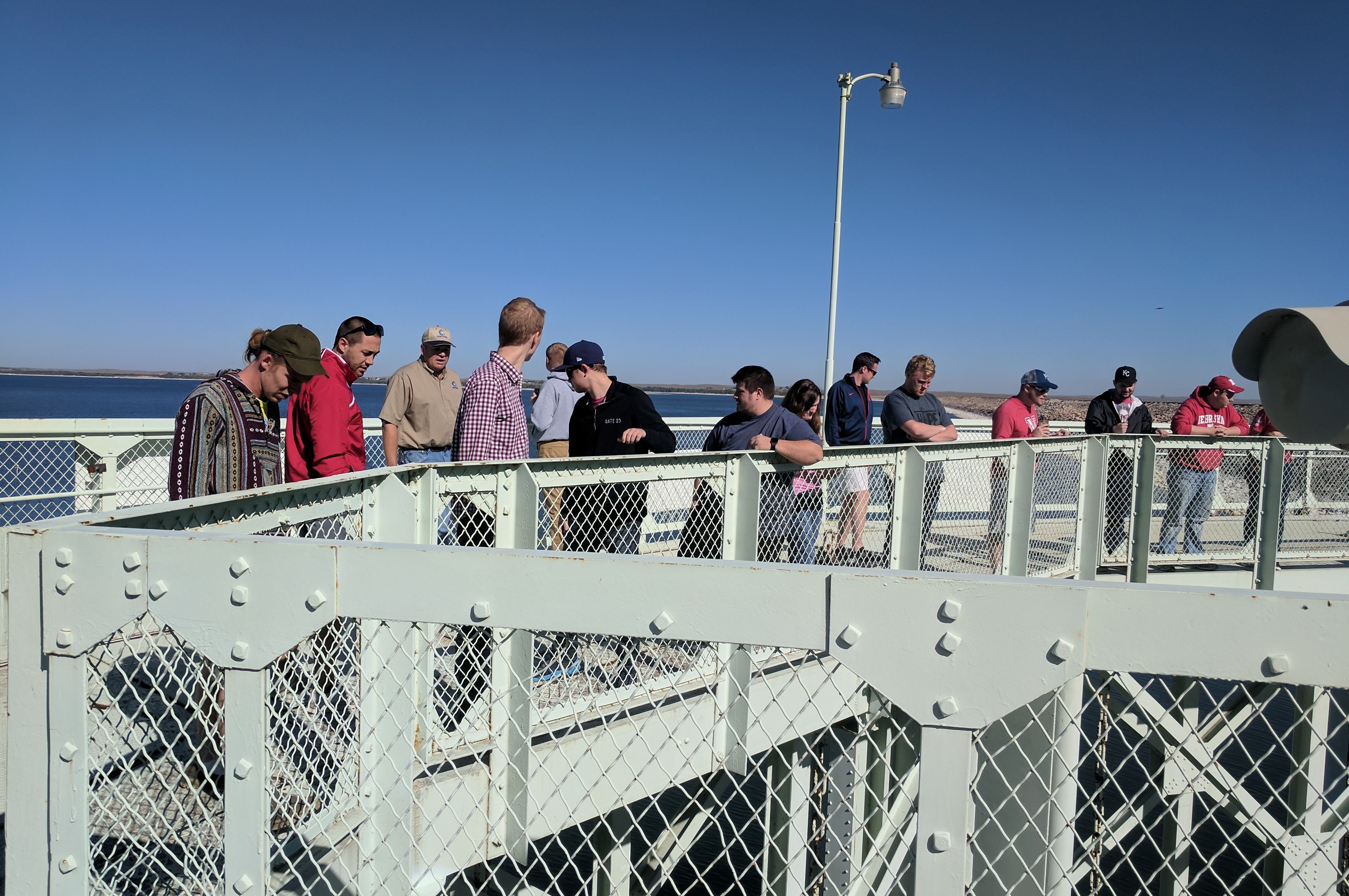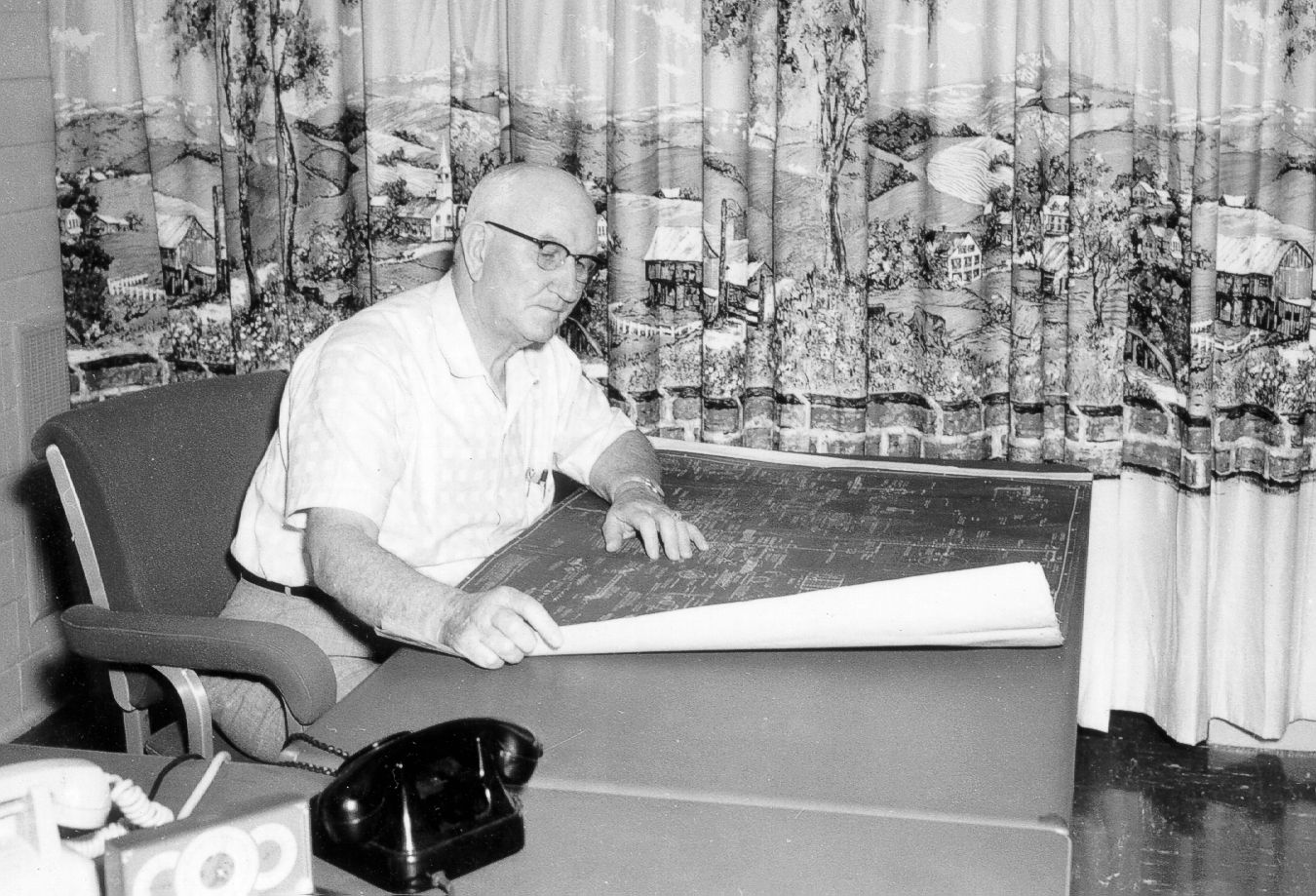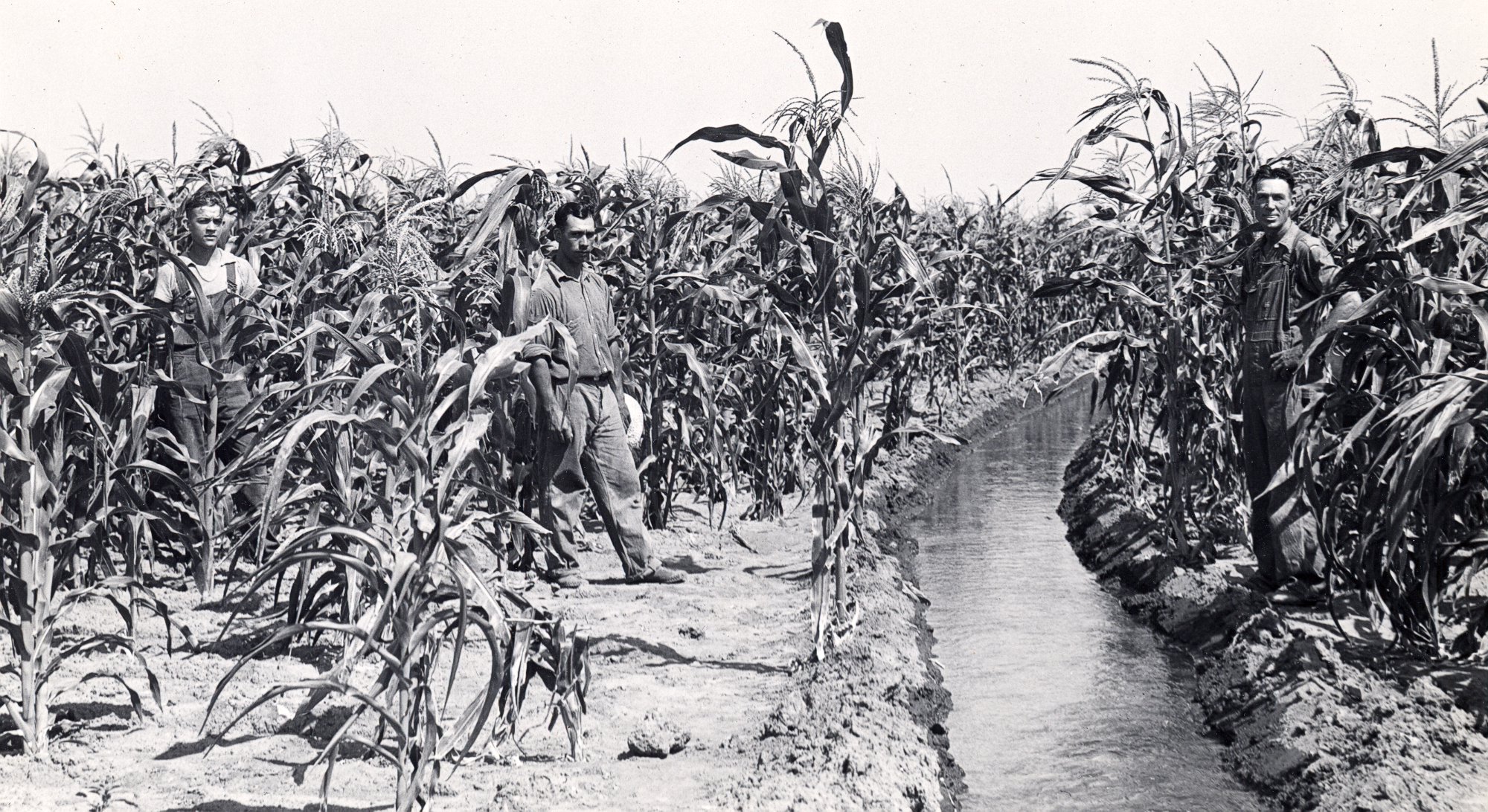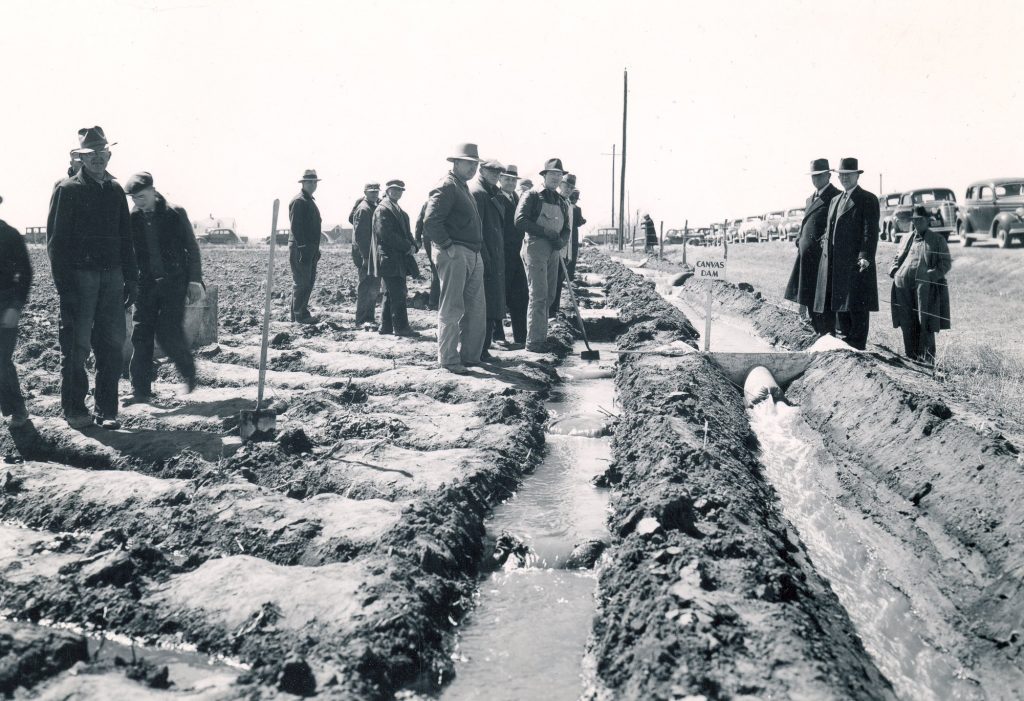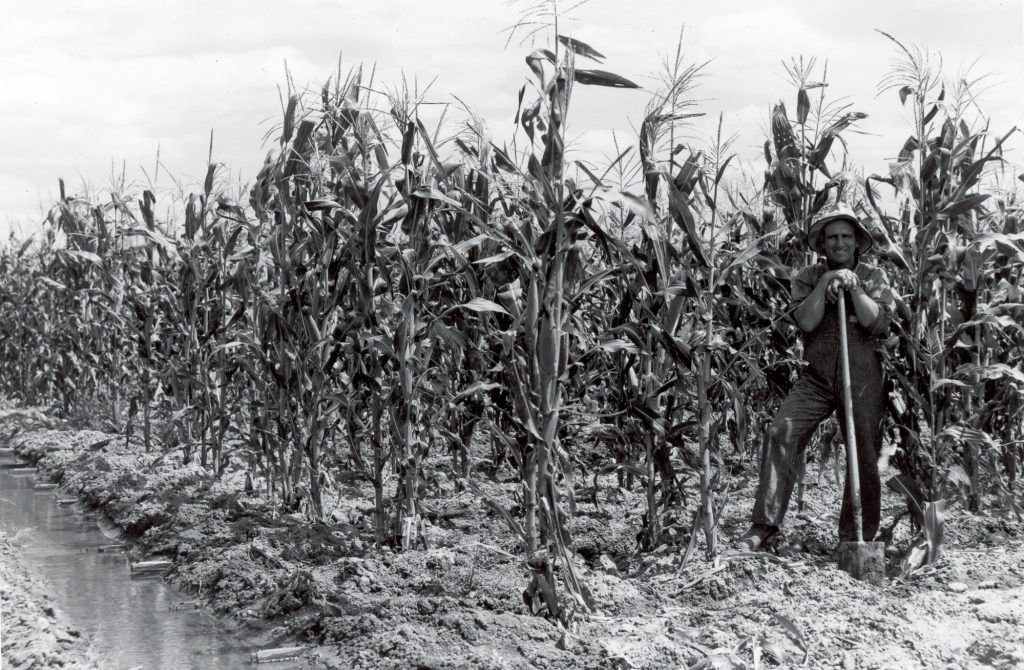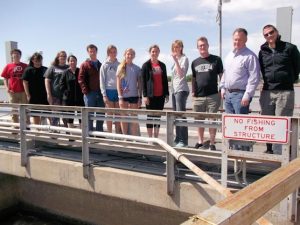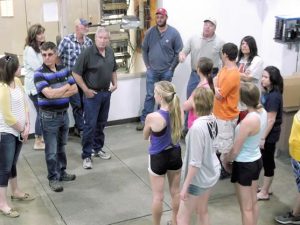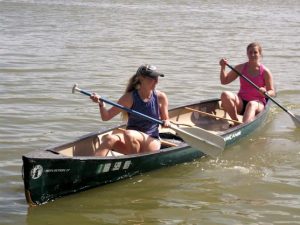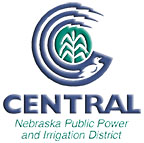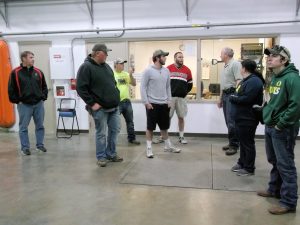The focus of the recent Water & Natural Resources Tour was on educating and informing participants about the many uses and benefits of water within the Platte River Basin between Ogallala and Holdrege, but there was plenty of fun, food and, yes, even exercise during the three-day tour.
What follows is a short(?) recap of the tour, along with some observations from the tour.
The tour participants – numbering more than 50 – assembled at Central’s administrative headquarters on the morning of June 27 and headed out via motor coach for the first stop at a site just south of the Platte River near between Elm Creek and Overton. The site is part of what is called the Cottonwood Ranch complex, which is owned by the Nebraska Public Power District and managed for wildlife habitat purposes by the Platte River Recovery Implementation Program (Program).

Jerry Kenny (with microphone) of the Platte River Recovery Implementation Program describes plans for a groundwater recharge/river flow enhancement project during the 2017 tour.
Part of the 3,000-acre ranch is comprised of grasslands and wet meadows and it is here that the Program is investigating prospects for a groundwater recharge project that will benefit base flows in the Platte River. The idea is to construct earthen berms around about 300 acres in the area, fill them with anywhere from six to 14 inches of water and allow the water to seep into the ground, which will eventually return to the river. The shallow water would also presumably attract migrating whooping cranes as a place to forage and roost.
From there the tour headed to the Tom Schwarz farm to check out one of the few organic farming operations in the area. It is here that Tom, his family and a few hired hands raise organic crops and vegetables in adjacent fields and small greenhouses. The greenhouses recently sustained heavy damage from a spring storm, but inside one of the relatively undamaged structures, Tom showed off rows of peppers, tomatoes and other vegetables that are being raised without pesticides, herbicides or non-organic fertilizer. Tom also has plans to begin a small organically raised cattle herd.
On the bus on the way to the next stop, John Thorburn, manager of the Tri-Basin Natural Resources District, explained the proposed Platte to Republican Diversion Project. The PRD Project, as it has become known, would deliver water from the E-65 Canal to the mouth of Turkey Creek through a pipeline bored beneath Highway 23 and the railroad tracks during times when there are excess flows in the Platte River. Any water appropriations granted by the Nebraska Department of Natural Resources would be junior to all current or future appropriations in the Platte River watershed. The project is intended to help reach objectives related to the NRDs’ Integrated Water Resources Management Plans and to assist in compliance with the Republican River Compact between Nebraska and Kansas.
After about 45 minutes at the Schwarz farm, the tour headed for Elwood Reservoir and the Carl T. Curtis Pump Station, which were added to Central’s system in 1977 to improve delivery surface throughout the E-65 Canal’s service area. The reservoir is also used for groundwater recharge purposes during the non-irrigation season and has become known as an excellent walleye fishery. Water is pumped into the reservoir at the pump station and then allowed to run back out by gravity when needed for irrigation deliveries.
The bus then traveled across the Johnson Lake dam; on the way the riders observed the synthetic membrane lining (a water conservation/canal efficiency measure) in the upper end of the E-65 Canal, the headgate of the canal and the inlet structure on the lake’s west side.
After a busy morning, lunch was served at the Monsanto Water Utilization Center near Gothenburg while Duane Woodward from the Central Platte Natural Resources District talked to the group about groundwater recharge efforts within the district.
After lunch the group headed out to the fields on pickup truck-pulled trolleys to examine studies of yields, insect and weed control, plant health and fertility, microbials, canopy height, drought stress and other topics. The tour participants also observed how the center’s “rain-out shelter” is used to ensure precipitation doesn’t interfere with studies involving drought resistance of crops.
(Author’s note: Keep in mind, all of these tour visits occurred on the same day, and we’re not finished yet!)
After a quick pause for refreshments, the group headed into Gothenburg for a tour of the Frito Lay Corn Handling Facility, where they learned that any of the snack chips consumed west of the Mississippi River originated as corn passing through this facility. Plant managers showed and explained to the group the control room, the load-out bays and the storage facilities at the plant.
The bus then headed down the street to Central’s Gothenburg Control Center from which operational monitoring and control of most of the District’s canal structures, pump stations and hydroplants is performed. Gothenburg Division Manager Devin Brundage also explained how the water passing through Central’s system originates as snow and rain in the Rocky Mountains of Colorado and Wyoming before passing through a series of U.S. Bureau of Reclamation reservoirs and several upstream irrigation projects before entering Lake McConaughy.
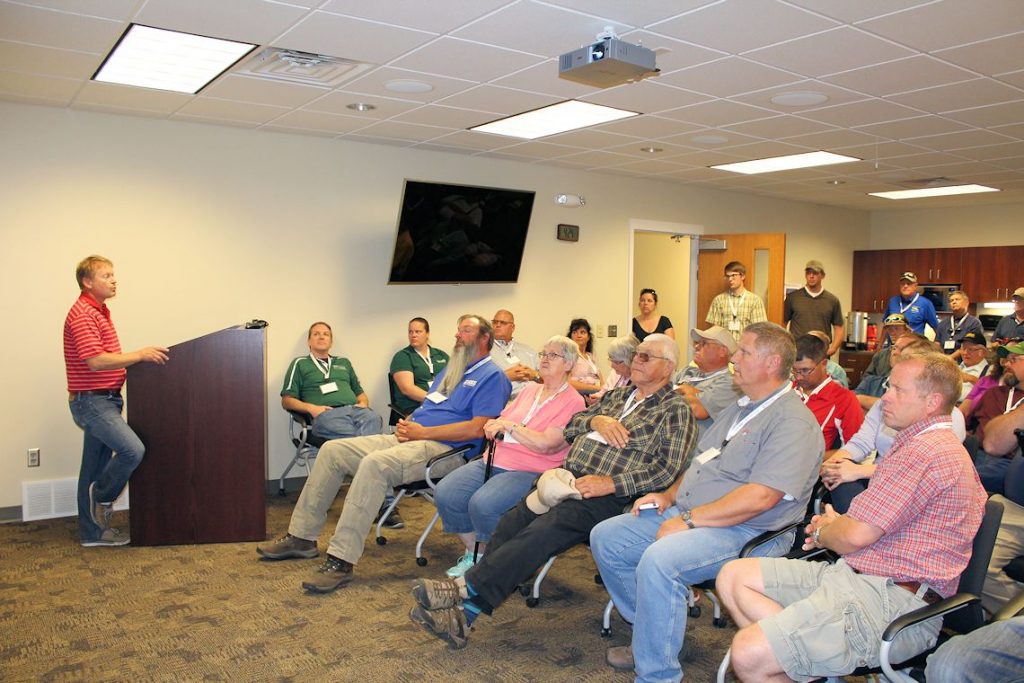
Central’s Gothenburg Division Manager Devin Brundage explains how the District’s control center operates the hydroelectric/irrigation project.
After checking into their North Platte motel, the group was treated to dinner and wine at the Feather River Winery and Vineyard, after which the vineyard’s owner explained how the facility came to be and the process of growing hybrid grapes for wine production in Nebraska’s often harsh climate extremes.
Day 2
After a good night’s rest (well-deserved given the pace of the first day!), the tour participants boarded the bus for a stop along NPPD’s Sutherland Canal at which a still-under-construction pipeline will eventually deliver water from the Nebraska Cooperative Republican Platte Enhancement Project (NCORPE) well field. A 19,500-acre farm was purchased in 2012 by a consortium of four NRDs (Upper Republican, Middle Republican, Lower Republican and Twin Platte), the cropland was converted to grassland and the irrigation wells – instead of feeding pivots – were hooked to a pipeline to deliver water to the Republican River Basin to help Nebraska’s compliance with the Kansas-Nebraska Republican River Compact. The pipeline currently under construction will move water north to the canal and then back to the South Platte River as part of the Twin Platte NRD’s efforts to offset depletions to the Platte River caused by groundwater pumping. TPNRD Manager Kent Miller and NCORPE manager Kyle Shepherd (who also participated in the entire tour) were on hand to explain the project’s details.
The next stop was nearby: the Nebraska Game and Parks Commission’s North Platte Fish Hatchery. Hatchery personnel, including manager Dirk Higgins, showed everyone around, including how the facility produces a variety of cool-water and warm-water fish species including walleye, white bass, blue catfish and channel catfish. When needed, the hatchery also produces yellow perch, black and white crappie, blue catfish, wiper, striped bass, bluegill, muskellunge, tiger muskie, smallmouth bass, grass carp, northern pike and largemouth bass. North Platte hatchery staff also makes annual collections of walleye and white bass eggs and milt from regional water bodies. A relatively new activity at the hatchery is an effort to raise freshwater mussels, which are becoming less abundant in Nebraska’s lakes, rivers and streams.
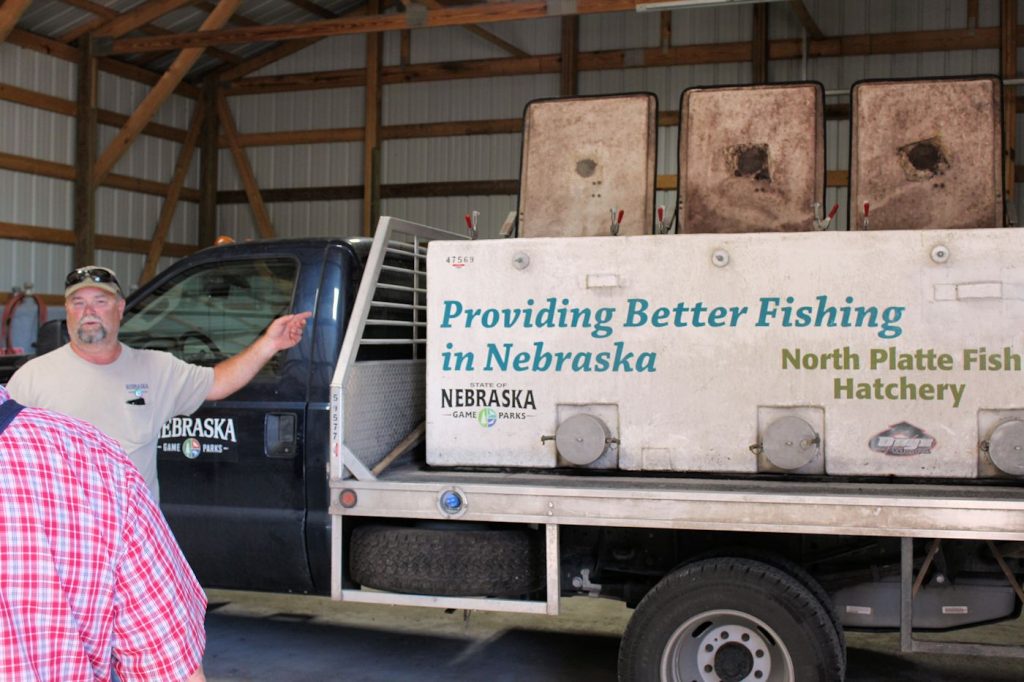
The manager of the NGPC fish hatchery at North Platte describes the process of stocking many species of fish into Nebraska’s lakes and streams.
The bus didn’t have to travel far to reach the next stop, the UNL West Central Research and Extension Center, just a mile down the road from the hatchery. At the center also known as the “State Farm,” Doug Hallum, Chuck Burr and Daran Rudnick explained current research activities on best management practices and measures to help producers get the most benefit from their water supplies. Entomologist Julie Peterson also explained how the center is investigating the use of biological controls (read: bugs and/or viruses that target insect pests on the farm) as possible tools to supplement or replace chemical pesticides.
Lunch was served at the “Farm” and the group departed for its next stop at NPPD’s Gerald Gentleman Station (GGS) near Sutherland. GGS is Nebraska’s largest power plant in terms of generating capacity. Station Manager Gerry Phelps and a team of tour guides from the station explained the plant’s operation from top to bottom and how water from Lake McConaughy is used to cool the condensers (returning the steam that passes through the turbines to a liquid state).
The tour also included a trip to the plant’s roof, where participants could see the coal yard and immense coal-handling equipment, the water works (including Sutherland Reservoir) and enjoy the view up and down the Platte River Valley.
After the 2-1/2 hour tour concluded, the bus headed for its Ogallala motel to prepare for dinner at the Haythorn Ranch north of Kingsley Dam. The participants were treated to a wonderful meal by Jody Haythorn and her staff at the Figure 4 Traditions banquet facility and also witnessed a spectacular sunset over the Sandhills. As the group lingered on the veranda in the fading light, turkeys strutted across a nearby pasture where a few horses seemed to completely ignore them. Begrudgingly, the group had to be prodded to board the bus and leave the idyllic setting as storm clouds – which would later bring torrential rain – began to roll in.

A gorgeous sunset — and an approaching thunderstorm — at the Haythorn Ranch north of Lake McConaughy where the tour group enjoyed a terrific meal and a wonderful atmosphere.
Day 3
The final day of the tour dawned clear and warm, with little evidence left from the previous night’s storm. The tour participants headed for the NGPC’s Lake McConaughy Visitors Center to browse through the facility’s Water Interpretive Center and listen to NGPC’s Regional Supervisor Colby Johnson explain the agency’s long-term Master Plan for recreational improvements at Lake McConaughy and Lake Ogallala. After a little more than an hour, the group boarded the bus for a tour of “Big Mac’s” outlet structures (the Outlet Tower and the “Morning Glory” spillway) and the Kingsley Hydroplant below the dam.

Devin Brundage appears for the second time on the tour, this time as tour guide for the Kingsley Hydro. Here he explains the operation of the hydroplant’s bypass valve.
Most of the tourists had never had the opportunity to peer down into the great bowl of the spillway and a few backed away from the railing at the sight of the gaping hole through which huge volumes of water could be released if necessary to control the lake’s elevation during high-water events. At the outlet tower, where the gates for normal releases of water lie at the bottom of the lake, no hands were raised when Central’s electro-mechanical technician Jason Meints explained the routine inspection process for the inside of the tower and asked for volunteers. All it involves is a slow ride down the 160-feet-deep shaft on a flimsy platform attached to a steel cable in pitch darkness. (To my surprise, I’ve never had anyone indicate an interest in going down the tower during similar tours, save for a few 15-year-olds who haven’t yet developed an aversion to dark and tight spaces.)
The group also enjoyed running … well, walking … several flights of stairs necessary to reach the generator floor and turbine-pit floor deep within the Kingsley Hydroplant. Gothenburg Division Manager Devin Brundage, pulling double duty as a tour guide, explained the workings of the largest hydroplant in Nebraska and answered questions from tourists experiencing their first visit inside such a facility.
When the group members had regained their breath after climbing the stairs back into the sunlight, the tour continued down the road to Ole’s Big Game Bar & Steakhouse for a steak lunch, one more opportunity to fuel up for the final event of the tour: a kayak trip down Central’s Supply Canal from just below Midway Lake near Cozad to the Gallagher Canyon Lake boat ramp, a stretch of 5.5 miles.
For most tour participants, it was their first opportunity to paddle a kayak, but everyone seemed to get the hang of the easily maneuverable crafts quite quickly. Those who chose not to paddle boarded a john boat and a pontoon provided to follow along. Since safety was a primary consideration, Jarrid Rickertsen – a Central employee at the Gothenburg office and a licensed emergency medical technician – piloted one of the boats and was prepared to use his EMT skills if necessary. Thankfully, there were no emergencies and the kayakers arrived at their destination in about two hours.
Along the way, the group enjoyed the scenery along the canal. High banks, plenty of birds, the occasional fish jumping out of the water or swimming just beneath, and a group of teenagers using one of the high banks as a platform from which they could jump/dive/flip into the canal 20 feet below.
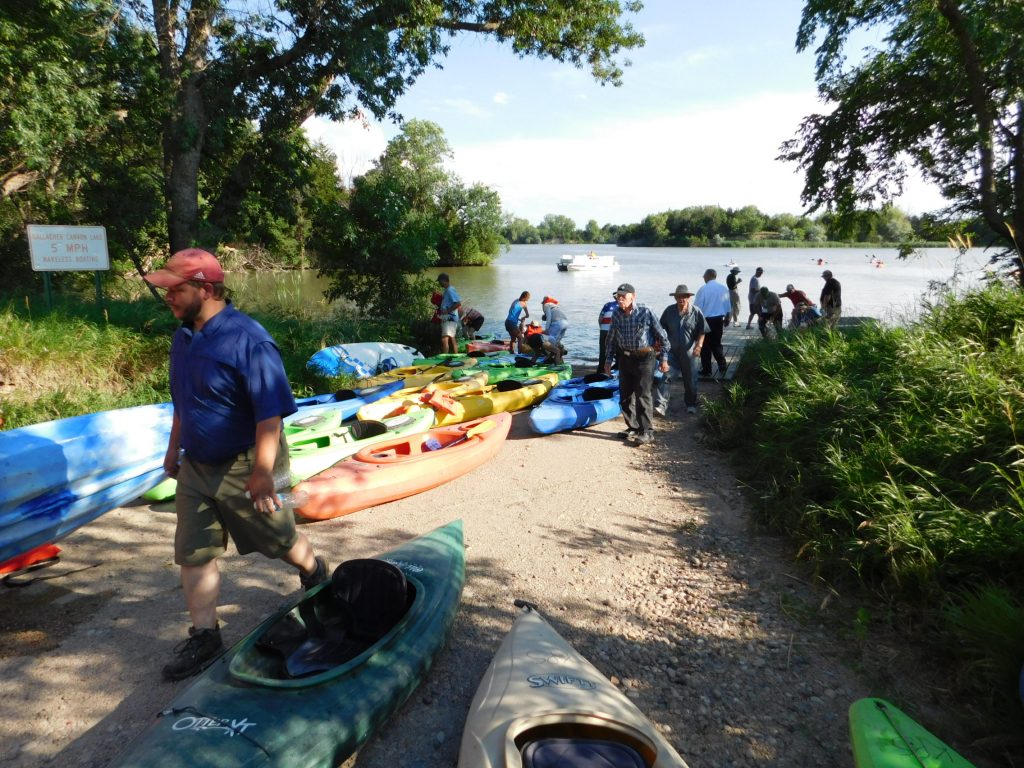
A tired, but triumphant group of kayakers climb the boat ramp at Gallagher Canyon Lake upon reaching the end of the 5.5-mile trip down Central’s Supply Canal.
Upon ending the kayak trip and re-boarding the bus, the tour concluded back in Holdrege with an impromptu pizza party in Central’s parking lot. Three or four dozen pizzas disappeared in short order as the participants gradually departed for home, many of whom expressed their enjoyment of the tour and asked about the destination for next summer’s tour.
The organizing committee, composed of Steve Ress and Tricia Leidle from the Nebraska Water Center; Ben Beckman, research and extension communication specialist from UNL; and Public Relations Assistant Holly Rahmann and myself from Central, will convene soon for a debriefing session on this year’s tour and review comments and suggestions from surveys filled out by participants. Then we’ll turn the page and begin planning for next year’s tour. The destination is unknown at this time, but we’ll try to choose a tour that will be interesting and enlightening, and most importantly, fun for its participants, continuing a tradition 40 years in the making.




